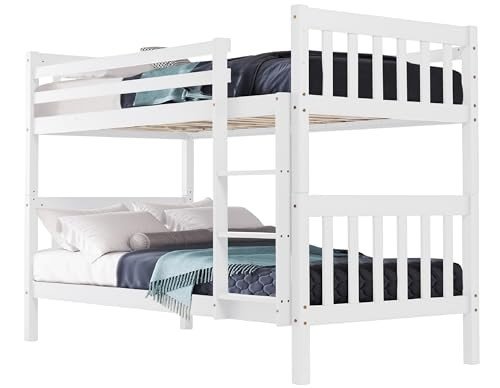Bunk Beds Sale: A Comprehensive Guide to Choosing the Right Bunk Bed for Your Home
Bunk beds have long been a staple in kids's bed rooms, using a mix of space-saving effectiveness and enjoyable. Whether accommodating brother or sisters, pals on pajama parties, or simply maximizing a playroom, bunk beds have become a vital element in modern-day household homes. As sales on bunk beds increase, it becomes significantly crucial for consumers to make educated choices when acquiring one. This short article will cover the basics of purchasing a bunk bed, from types to safety features, along with suggestions for preserving the integrity of your investment.
Types of Bunk Beds
When thinking about a bunk bed sale, it's crucial to understand the different designs readily available on the market. Below are the most typical types:
- Traditional Bunk Beds: These consist of 2 beds stacked one above the other, sharing a single frame. mouse click the following web page are often the most cost-effective option.
- L-Shaped Bunk Beds: This design includes one bed positioned vertically and another horizontally. This arrangement creates extra space beneath the upper bed, which can be used for storage or a backyard.
- Lofted Beds: Similar to conventional bunk beds but with no lower bed. Instead, the space below can be made use of for a desk, play area, or extra storage.
- Triple Bunk Beds: For households with a larger variety of children or regular slumber parties, triple bunk beds provide three sleeping locations in a space-efficient style.
- Futon Bunk Beds: These designs combine bunk beds and futon sofas. The bottom area converts into a different seating area, boosting functionality.
- Convertible Bunk Beds: These beds can be separated into 2 individual beds, making them versatile as children's needs change with time.
Table 1: Comparison of Bunk Bed Types
| Type | Description | Space Efficiency | Additional Features |
|---|---|---|---|
| Conventional Bunk Bed | 2 beds stacked vertically | High | Most basic design |
| L-Shaped Bunk Bed | One vertical and one horizontal bed | Moderate | Play or storage space |
| Lofted Bed | Elevated bed with open space listed below | High | Work/play location |
| Triple Bunk Bed | 3 stacked beds | Extremely High | Accommodates more users |
| Futon Bunk Bed | Bunk bed with a convertible futon | High | Multi-functional |
| Convertible Bunk Bed | Can be divided into 2 separate beds | Moderate | Flexibility & & longevity |
Safety Features to Consider
Security is paramount when investing in a bunk bed. Below are crucial safety features to look for:
- Guardrails: Adequate guardrails must be present on both sides of the upper bunk to avoid falls. They ought to be at least 5 inches greater than the bed mattress.
- Ladder Design: Look for tough, wide ladders with slip-resistant rungs. Guarantee that the angle is not too high for simple gain access to.
- Stability: Ensure the bed is built with strong products, such as solid wood or heavy-duty metal. The bed needs to not wobble when in use.
- Weight Limit: Check the weight capacity of the bunk bed to guarantee it can accommodate the desired users securely.
- Product Safety: If possible, select beds made from non-toxic materials or those meeting safety requirements for kids's furniture.
Table 2: Essential Safety Features
| Function | Description | Significance |
|---|---|---|
| Guardrails | Sides of upper bed to avoid falls | Important for kid safety |
| Ladder Design | Solid, slip-resistant rungs | Help safe and simple access |
| Stability | Construct quality to avoid wobbling | Guarantees safety and durability |
| Weight Limit | Optimum weight capability | Avoids accidents |
| Material Safety | Non-toxic, safe materials | Protects children's health |
Upkeep Tips for Bunk Beds
To extend the life of your bunk bed and ensure ongoing safety, think about the following maintenance pointers:
- Regular Inspections: Periodically check the structure for loose screws, bolts, or any indications of wear. Tighten up fasteners as needed.
- Clean Periodically: Dust and clean the surface areas routinely. Usage suitable cleaners that won't damage the finish.
- Check Weight Limits: Be conscious of weight limits, particularly with older children or adults who might wish to use the upper bunk.
- Avoid Climbing on Guardrails: Educate children not to utilize guardrails for climbing up or playing to reduce the threat of accidents.
Regularly Asked Questions (FAQs)
Q1: What is the age limitation for children to safely use bunk beds?A: While it differs by the maker, lots of suggest that children under 6 ought to not sleep in the upper bunk due to safety concerns.
Q2: How can moms and dads dissuade unsafe climbing?A: Setting clear rules about bunk bed usage and monitoring kids can help. Additionally, utilizing a bed camping tent can discourage climbing while creating an enjoyable sleep environment.
Q3: What should I think about when decorating a room with bunk beds?A: Ensure there suffices space around the bunk bed for safe movement, and make use of the decoration to develop individualized spaces for each child.
Q4: Is a lofted bed suitable for older kids?A: Yes, lofted beds can be suitable for older kids as long as they fulfill security requirements and the kid is responsible enough to utilize them safely.
Bunk beds serve a practical purpose while adding a component of fun to a child's bed room. As sales of bunk beds continue to increase, careful factor to consider of types, safety features, and upkeep practices is vital for moms and dads and caregivers. By comprehending these important elements, families can find the perfect bunk bed for their home, ensuring both usefulness and safety for many years to come. Whether it's for brother or sisters sharing a room or creating a comfortable sleepover space, a well-chosen bunk bed can offer happiness and practicality, making it a worthwhile investment.

